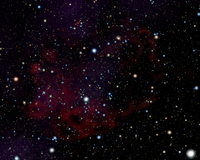Gum Nebula
 From Conservapedia
From Conservapedia | Gum nebula | |
|---|---|

| |
| Observational Data | |
| Designation | Gum 12a |
| Right ascension | 07h 53m[1] |
| Declination | -42° 06′[1] |
| Constellation | Puppis |
| Type of object | Emission nebula |
| Dimensions | 35° across[2] |
| Magnitude | Apparent Mag: >6 |
| Astrometry | |
| Distance from Earth | 1,300 ly[3] |
The Gum nebula (Gum 12a) is a large emission nebula in the constellations of Puppis and Vela.[2] A complex cloud of gas, it is the largest emission nebula on the night sky, measured by its apparent size of 35°.[2] This large size actually makes it difficult to see or photograph. Photographs of the nebula are normally made from a mosaic of zoomed in photographs. The nebula was discovered by the Australian astrophysicist Colin S. Gum whilst working at the Mount Stromlo Observatory in Australia[4] Gum gave the nebula the designation Gum 12a in his catalogue, the Gum Catalgoue, which is still in use today. It has been proposed that is the remnant of a supernova.[2] The Vela supernova remnant is contained within this nebula.[5]
Properties and Structure[edit]
At 35° across, the Gum nebula is by far the largest emission nebula known and covers an area of sky several times that of the Moon. It's distance of some 1,300 light years means that is roughly 1,000 light years across.[2] The radiation emitted by two stars located within the nebula, ζ Puppis and γ2 Velorum, caused the hydrogen gas in the nebula to glow.[3] The gas in the nebula has a density of around 2 particles cm−3.[3]
References[edit]
- ↑ 1.0 1.1 Gum nebula from simbad.u-strasbg.fr
- ↑ 2.0 2.1 2.2 2.3 2.4 Gum Nebula from britannica.com
- ↑ 3.0 3.1 3.2 Ramachandran, R.; Mitra, D., 2001. Scatter broadening of pulsars in the direction of the Gum nebula. Astronomy and Astrophysics, [Online]. 370, 586-590. Available at: aanda.org (Accessed 18 January 2018).
- ↑ The Gum Catalog from galaxymap.org
- ↑ The Gum Nebula from apod.nasa.gov
Categories: [Astronomy] [Nebulae]
↧ Download as ZWI file | Last modified: 02/27/2023 10:48:18 | 15 views
☰ Source: https://www.conservapedia.com/Gum_nebula | License: CC BY-SA 3.0
 ZWI signed:
ZWI signed: KSF
KSF